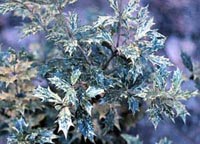Resource Library
Plant of the Week: Osmanthus, Holly (False Holly)
The University of Arkansas System Division of Agriculture does not promote, support or recommend plants featured in "Plant of the Week." Please consult your local Extension office for plants suitable for your region.
Plant of the Week
Holly Osmanthus, False Holly
Latin: Osmanthus heterophyllus 'Goshiki'

Variegated plants, or plants with several different colors, offer much to the garden, especially in the shade. They brighten up dark corners, break up green masses and generally provide a pleasant contrast to their surroundings. Because variegated plants are some of my favorites, I must constantly remind myself that their role is as an accent in the planting, not as a major component. The Goshiki Holly Osmanthus is one of the most interesting variegated plants to surface in a long time and one that will enjoy wider usage as it becomes better known.
The Holly Osmanthus is an evergreen shrub which superficially resembles a holly. The two species can be easily separated by examining the arrangement of leaves on the stem. In Osmanthus the leaves are opposite one another while in holly they are alternate. The Holly Osmanthus has spiny leaves like Chinese holly, but in Osmanthus the spines are softer and less prone to puncture than the holly. The leaves are to about two inches long and half as wide with seven to nine spines.
In the variety ‘Goshiki’-- which translates from Japanese as "five colors" -- new leaves unfold maroon red and quickly turn green. The green leaves are daubed with spots of creamy white, gray-green, and yellow-green. The variegation pattern looks like a careless painter had splattered the plant with paint.
Osmanthus are fall flowering with small white, four-petaled blooms hidden in the foliage.
Blooms appear in September and October and are pleasantly fragrant, sometimes to the extreme. The plants do not set fruit in cultivation.
‘Goshiki’ is becoming common in nurseries throughout the south. It was introduced from Japan by Barry Yinger who, at the time, was working for the Brookside Botanic Garden in Wheaton, MD. His collecting work includes fewer treks into the wilderness than his 19th century counterparts but is none the less important. He found Goshiki Holly Osmanthus listed in the 1980 catalog of Nihon Khaki Nursery in Japan. Yinger currently works for Hines Nursery in California, a firm which has been instrumental in introducing a number of new plants into the US nursery trade.
The Japanese have a passion for variegated plants as is shown by the wide assortment of Aucuba, Hosta and Miscanthus that have been collected there over the years. The Japanese garden is a serene space intended to symbolize nature, not improve upon it as we try to do in our Western gardens. Because of the serenity of the Japanese garden, flowers are seldom used. A single variegated plant in a container might be used as a color accent, but would not likely be planted directly in the garden.
‘Goshiki’ Holly Osmanthus is reliably hardy in the southern two thirds of the state, but should be hardy statewide if given a sheltered location near a building in the upland parts of the state. It should be planted in partial shade in a well drained soil that can be watered during dry spells. This colorful shrub makes an interesting accent plant near entry ways or planted amongst evergreens where its unique variegation pattern can be displayed.
By: Gerald Klingaman, retired
Extension Horticulturist - Ornamentals
Extension News - August 18, 2000
The University of Arkansas System Division of Agriculture does not maintain lists of retail outlets where these plants can be purchased. Please check your local nursery or other retail outlets to ask about the availability of these plants for your growing area.